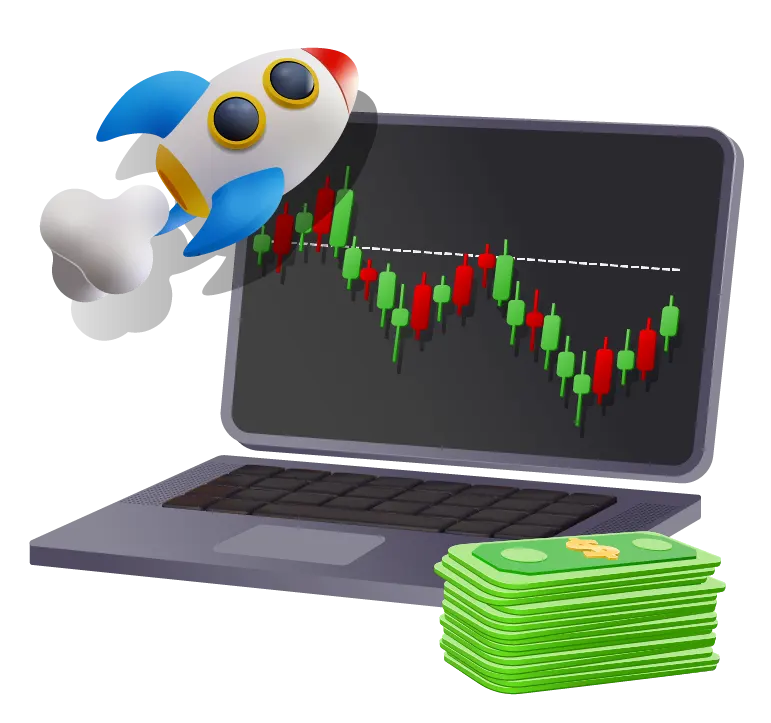Have you thought about getting into Forex trading? You’ve probably heard it from a friend or someone you know, but this topic seems very distant and complicated. Getting started will require time and resources, but with the right knowledge and tools, Forex trading can be a financially rewarding endeavor. This article will help you learn the basics of Forex trading and how to prepare before you start trading effectively.
Content
What is Forex trading?
How does Forex trading work?
Pros and cons
Basic steps for beginners
Summary
What is Forex trading?
Forex is the largest market in the world, with daily trading volume exceeding $6 trillion. Various national currencies are traded on it. It is extremely dynamic, operating 24 hours a day, five days a week.
A characteristic of Forex is that currencies are traded in pairs, meaning that you simultaneously buy one and sell another. For instance, when you trade EUR/USD, buying EUR means you are simultaneously selling USD. The pair’s rate changes depending on various economic indicators and market conditions, which creates an opportunity for traders to realise profits.
How does Forex trading work?
The Forex market is decentralized, meaning that there isn’t one central institution that manages all transactions. Instead, it operates through a global network of banks, brokers, and financial institutions that service international transactions. This network allows traders to participate anytime and from anywhere in the world through online platforms.
Basic concepts:
- Currency pair - currencies are traded in pairs such as EUR/USD. The first currency in the pair is the base currency and the second is the quote currency. The price of the currency pair indicates how much of the quote currency is needed to buy a unit of the base currency;
- Pip - a pip is the smallest price movement in a currency pair, typically represented by the fourth decimal place.
- Lot - trades are measured in lots. A standard lot is 100,000 units of the base currency, a mini lot is 10,000 units, a micro lot is 1,000 units, and a nano lot is 100 units;
- Bid & Ask price - the bid rate is the price you receive when selling a currency, while the ask rate is the price you pay when buying a currency. The difference between the bid and ask rates is known as the spread.
- Leverage - brokers offer leverage that allows you to control larger positions with a smaller amount of capital. For example, a leverage ratio of 1:100 means you can control $100,000 with $1,000. Although leverage can increase profits, it also increases risk proportionately.
Pros and cons
Pros
- Liquidity - the Forex market is extremely liquid, which means you can quickly open and close multiple trades no matter the volume;
- Convenience - you can trade at any time and use various platforms;
- Leverage - using leverage allows you to control larger positions with a smaller amount of capital;
- Various strategies - You can use various strategies and conduct both technical and fundamental analyses to make well-informed trading decisions.
Cons
- Risk - in Forex trading, there is a significant risk of losing funds, particularly when leverage is used;
- Complexity - understanding the market requires knowledge of economic indicators, technical analysis, and market sentiment;
- Depending on a broker - your experience may depend heavily on your choice of broker. Those not recognized by financial authorities may pose a risk to your investments.
Get up to $1 Cashback per lot and join the Trendline traders community!
At TRENDLINE, we have carefully selected some of the best Forex brokers in the world. See 7 reasons why you should trade with them.
Basic steps for beginners
If you're a beginner, stick to these basic steps:
- Learn - take advantage of online courses to learn the fundamental concepts and details of the financial markets.
- Choose a broker - choose a reputable broker that offers a reliable trading platform and make sure that it is regulated by a recognized financial authority.
- Open a demo account - initially start with a demo account to get a feel for the market without the risk of losing real money.
- Work on your strategy - based on what you have learned and experienced with a demo account, develop a trading strategy and stick to it.
- Start trading small - start with low-risk trades so you can manage your risk more easily. As you gain experience and confidence, you can gradually increase the size of your trades.
FREE FOREX TRAINING FOR BEGINNERS
If you want to trade GOLD, FOREX or other instruments and make real profits, our trading course is just for you. A complete beginner's guide in 38 video tutorials.
Summary
The world of Forex trading is an exciting adventure, but it also carries significant risks. Once you understand the basics, have a reliable broker to trade with, and develop a good trading strategy, that’s when you can start trading Forex. Never stop learning and don't forget to stay informed, test new strategies, and constantly strive to improve your trading skills.
Risk Warning: All products and services offered by "Forex Trendline" Ltd are for educational purposes only and do not constitute investment advice or a trading recommendation. Trading financial instruments carries a high level of risk and may result in losses. Past performance is not a guarantee of future success. We recommend that you read the full Terms and Conditions before using our services. Nothing on this site should be interpreted as investment advice from "Forex Trendline" Ltd or any of its representatives, directors, or employees.
© 2025 Trendline. All rights reserved

